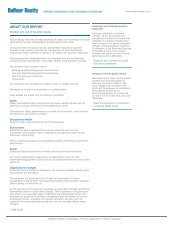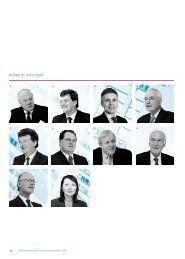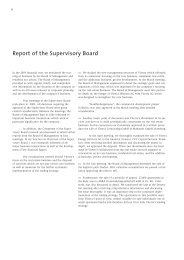E_mg_GB_03_vorne-29_3_04
E_mg_GB_03_vorne-29_3_04
E_mg_GB_03_vorne-29_3_04
You also want an ePaper? Increase the reach of your titles
YUMPU automatically turns print PDFs into web optimized ePapers that Google loves.
MANAGEMENT SHARE STRATEGY SPECIAL SECTION MANAGEMENT REPORT FINANCIAL STATEMENTS FURTHER INFORMATION<br />
Production<br />
Economic Environment • Situation of the Company • Organization and Structure • Risk Report • Employees • Performance of the Subgroups • Outlook<br />
The <strong>mg</strong> Group operates in each of its markets through decentrally managed operating business units,<br />
as this structure provides it with a high degree of flexibility and customer focus.<br />
The various production strategies are strictly geared to customer requirements and the respective<br />
market structure. The spectrum ranges from products individually produced to order via line and batch<br />
production to flexible manufacturing cells. <strong>mg</strong> is constantly reviewing its production parameters to<br />
ensure it meets the highest standards of performance and efficiency. Key benchmarks include throughput<br />
times, productivity by area, zero-error production, and the ability to meet customers’ just-in-time<br />
and just-in-sequence requirements.<br />
In Sarstedt, in the Netherlands, GEA Ecoflex GmbH, which specializes in the manufacture and development<br />
of plate heat exchangers, built a new workshop and a new pressing line for the production of<br />
heat exchangers. This will enable the company to expand its production capacities substantially and to<br />
set new standards in the industrial production of plate heat exchangers: the new pressing line, which<br />
has 15,000 tonnes of stamping power, is generally regarded as one of the most modern of its kind in<br />
the world. By committing this level of investment, the GEA subsidiary plans to grow its share of the<br />
global market and further improve the quality of its products.<br />
GEA’s air-treatment business successfully completed the restructuring of its production activities.<br />
It concentrated a large proportion of its production facilities for industrial air-treatment equipment<br />
at Liberec in the Czech Republic, where GEA already manufactures air-treatment equipment. The<br />
concentration of its production capacities in Liberec will enable it to reap synergies and enhance<br />
its competitiveness. By expanding its production facilities in eastern Europe, GEA’s air-treatment<br />
business is also responding to the growing demand in this region.<br />
Under the umbrella of Dynamic Synthesis, Dynamit Nobel is making significant advances in the<br />
production of active ingredients for pharmaceuticals. For the pharmaceutical industry, it develops<br />
intermediates and active ingredients that are produced in complex chemical reactions.<br />
During the period under review, the special-chemistry business in Leverkusen, Germany, increased<br />
its capacities for the production of pharmaceutical active ingredients based on azide chemistry.<br />
In order to significantly increase its production capacities for the extraction of active-ingredient<br />
molecules, Dynamit Nobel invested over a11 million in the refurbishment of a multi-column chromatography<br />
(MCC) plant at Finorga’s site in Mourenx, France. This is one of Finorga’s proprietary<br />
technologies, which is used to separate identically structured molecules with varying effects according<br />
to type. These molecules – so-called ‘enantiomers’ – are found in roughly 75 percent of all newly<br />
developed drugs. They are used, for example, in medicines for the treatment of depression. By continuing<br />
to expand its technological and production capabilities, Dynamit Nobel remains an important<br />
value-adding partner to the pharmaceutical industry.<br />
53









